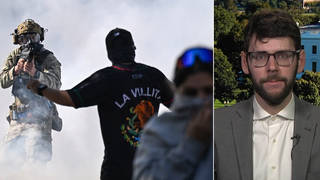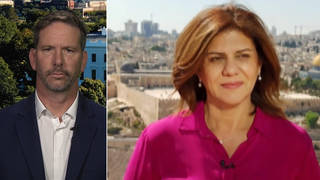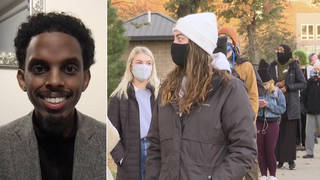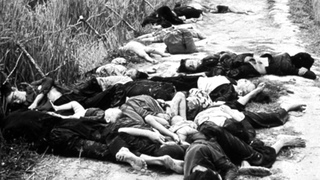
Guests
- Seymour Hershinvestigative journalist for The New Yorker magazine. He won the Pulitzer Prize for his expose of the My Lai Massacre.
This weekend marked the fortieth anniversary of the My Lai Massacre, when US troops killed more than 500 men, women and children in Vietnam. We speak with investigative journalist Seymour Hersh, who won a Pulitzer Prize for exposing the killings and the cover-up. [includes rush transcript]
Transcript
AMY GOODMAN: Today, we begin our series, “1968, forty years later.” This weekend marked the fortieth anniversary of the My Lai Massacre. On March 16th, 1968, the members of Charlie Company arrived in the village of My Lai in the northern province of South Vietnam. The soldiers opened fire even though they had not come under attack. The violence quickly escalated into an orgy of killing. More than 500 villagers were murdered, most of them women, children and the elderly.
When the massacre was uncovered, it proved to be a turning point for American public opinion about the war. The only US soldier convicted over the killings was Lieutenant William Calley.
On Sunday, more than a thousand people turned out in My Lai to remember the victims. The memorial drew Vietnamese survivors and family members, returning US war veterans, peace activists and a delegation of atomic bomb survivors from Hiroshima and Nagasaki. Among those attending was Larry Colburn. He was a member of a three-man US Army helicopter crew that landed in the midst of the massacre and intervened to stop the killing.
LARRY COLBURN: No one wins in war, and civilians always suffer in war. And the only way to prevent atrocities in war is to prevent war.
AMY GOODMAN: While the My Lai Massacre took place on March 16th, 1968, it wasn’t until November 12th, 1969 that the world found out about it. That’s when investigative journalist Seymour Hersh broke the story about the massacre and its cover-up. He was awarded the Pulitzer Prize for his expose. Forty years later, Seymour Hersh is still breaking stories about war. In 2004, he exposed the Abu Ghraib scandal in The New Yorker magazine. Seymour Hersh joins us now from Washington, D.C.
Welcome to Democracy Now!
, Sy.
SEYMOUR HERSH: Good morning.
AMY GOODMAN: Let’s go back forty years ago. Tell us what happened on that day.
SEYMOUR HERSH: Well, what happened is they — this is a unit — look, the analogy with Iraq is pretty acute. Basically, it’s a group of soldiers that landed. They were mostly uneducated high school graduates and dropouts who were told they were fighting communism, going to save America. They got to Vietnam. They spent ten, eleven weeks in the — you know, humping it in the boonies and in the villages and paddies of South Vietnam and never saw the enemy. Maybe they lost 15 or 20 percent of their company through snipers, land mines, etc., but they never engaged. And over the period of ten, eleven, twelve weeks, between the period they landed around New Year’s Day of ’68 until March 16th, they became increasingly brutal, so randomly going through a village and whacking people, sometimes an old man they saw. One soldier would just hit him with a rifle butt, and nobody said anything, because what happens inevitably is when you don’t see an organized enemy and you lose people, you lose your buddies and your mates, and you’re angry, you take it out on the villagers, you take it out on the civilian population, as you were just hearing, as we were all listening this morning to the testimony.
And so, one night they were told — the kids were told, “Tomorrow, you’re going to meet the enemy. The North Vietnamese — a regular North Vietnamese battalion is going to be there, and you’ll get a chance to get payback.” And the kids did then what they did then: the young soldiers toked it up, and the senior enlisted men and the officers drank it up. But they all got up at 3:00 or 4:00 in the morning, jumped on choppers and went to kill and be killed — you have to give them their due. And they got into the village, and there’s no soldiers there. The intelligence was bad, as it always is. And they gathered people. There was no fire at all, really, just old women, men and children making their — heating up water for their morning rice. And they gathered them eventually into three large ditches and began to execute them.
Calley was — become infamous, but there were five or six first and second lieutenants that were also organizing it. And as I later wrote and learned about — I spent a couple years sort of obsessing with, I wrote a couple books about it. One was about the cover-up. Almost, during the day, every senior officer, including the major general in charge of the Americal Division — this group was assigned to the Americal Division — all were flying over the area at one time, and pretty much everybody knew pretty much what was going on. There you are.
And I’ll tell you, Amy, just — there was one of the kids who did a lot of shooting, was a young man named Paul Meadlo from a little small hamlet called New Goshen, Indiana. And talk about repressed memory. I learned about this a year — almost a year and a half later. I was working in Washington as a freelance writer and began just — I had followed the war and knew what was going on in some visceral way and knew what was — there was something there. And I began — I finally got to the point where I began to find kids in the unit, and I was writing stories. I think I wrote five in five weeks as a freelancer. And it was just as the young boys talking over the weekend were ignored by the press, I had a hell of a time getting the major press to run the stories, for sure. This is always the way it is. You know, there’s always a disconnect between the bad stuff that goes on that everybody knows goes on and what I guess you could call the mainstream press want to write about. I don’t know why, but it’s true, there always is.
And in any case, one repressed memory that I didn’t learn about until I was deep into the story — written two or three pieces — concerned this young man who did a lot of shooting. His name was Meadlo, as I said. He simply fired clip after clip. He was one of those — like an automat, just shot and shot into the ditch. They put people, as I said, in three large ditches. And after the shooting was over, the soldiers went and were eating their lunch, really literally next to the ditch, next to the bodies. And that’s how disconnected you get. You know, you dehumanize —- you obviously have to dehumanize the enemy, as we’ve listened to this morning.
In any case, one mother tucked a child, a two— or three-year-old boy, under her stomach, and somehow he survived all the bullets. And they heard a keening noise, the soldiers told me. And this little boy climbed his way up through the ditch full of other people’s blood, got to the top and began to run across the — you know, just to run away. And Lieutenant Calley turned to Meadlo, his most dependable shooter — others had stopped at a certain point or shot high — and said, “Meadlo, plug him.” And Meadlo looked at one person and couldn’t do it. And Calley then, with a great — you know, very saucy-like — grabbed his carbine — officers had a smaller rifle called a carbine — ran behind him and shot him.
Everybody remembered that, because the next morning, Meadlo was walking on patrol with the soldiers — they moved on to a few clicks away, a mile or so away, and began to patrol again, as they always did — just another day’s work, I guess. I don’t know. And he stepped on a land mine — Meadlo did — and blew his right leg off at the knee. And when the medevac was coming — they called in a chopper to take him away — he began to issue an oath: “God has punished me, Lieutenant Calley, and God will punish you. God has punished me.” And the kids, in telling me about this a year and a half later, all remembered how angry they were. “Get him out of here! Get him out of here!” They didn’t want to hear this.
And, anyway, I obviously went looking for him. What a story! It took me a long time. We didn’t have internet then. I remember I was in Salt Lake City calling various — I knew he was from Indiana. I knew how to spell his name. I finally found the house, town called New Goshen. I flew overnight to Chicago, then — New Goshen is below Indianapolis, which is below Terre Haute, which is below — anyway, it took me forever, and I finally found this house.
And here’s this old ramshackle chicken farm, chickens all over the place, no man clearly around. And I had spoken to Meadlo’s mother the night before, and she said, “Well, I don’t know what he’ll do.” And I said I’ll be there the next day, and I show up, and she comes out to greet me. She’s maybe fifty, looks seventy. Everything is in disrepair. And I said I wanted to see her son. She said, “He’s in the house.” And I said, “May I go?” And she said, “I don’t know if he’ll talk to you.” And then this woman, this sort of uneducated, very rural woman from on the banks of the Wabash River and very south of southern Indiana, she looked at me, and she said — very angry and very low — she said, “I gave them a good boy, and they sent me back a murderer.” And, you know, you hear those stories. I’m right there. It’s a moment you’ll never forget. And I — no matter how much I write about it, I still think about it. And we’re just hearing it today all day, again and again. And the bottom line is, this is what war is.
AMY GOODMAN: Seymour Hersh, what about Larry Colburn? What about the guys who came down in the helicopter to try to stop this?
SEYMOUR HERSH: They did try to stop it. They jeopardized their career. They actually drew their weapons, which was quite amazing. And they did stop the — in the short term, they stopped the slaughter of a bunch of women and children who had taken refuge in a cave or in a complex, an underground complex, and they did stop them from being shot immediately. I don’t know whether they were shot eventually or not.
AMY GOODMAN: What do you mean they drew their weapons? They drew their weapons on their fellow soldiers?
SEYMOUR HERSH: Yes. The machine gunners turned — he was a door gunner, machine gunner, in a chopper. And he — they pointed them at their fellow soldiers, absolutely. Other soldiers in the unit — I think there were about eighty guys that went in, and I think I must have, in the next six months, talked to fifty or sixty of them. And there was a racial distinction that was interesting. I don’t know. It seemed to me, just on the basis of when I talked — of those I talked to, a very rough — that the vast majority of the African American and Hispanics shot, but shot high. It was just — you know, it was the white boys’ deal, they thought. They just — they were afraid not to shoot, because they didn’t want — they were afraid of getting a bullet from their fellow soldiers if they did not shoot, so they shot. And so, you did have occasions — there was differentiation. Not everybody was an automat like Meadlo and shot everything every time an officer asked them to. There was distinctions.
And Colburn and Thompson and the others — but they were waved off. They were — everybody was exceedingly angry at Thompson. When he got back, he was chewed out, you know, for being unprofessional, etc., etc. And Thompson, at one point, took a medal that talked about his bravery, was sort of like — he did do it, he was sorry he did it later. It was complicated, because those who behaved correctly were the ones who were in the wrong, in terms of what was going on that day.
AMY GOODMAN: Seymour Hersh, Gareth Porter did a piece at antiwar.com, “My Lai Probe Hid Policy that Led to Massacre,” the whole issue of this being described as some kind of rogue operation that had no official sanction. And he said, for decades, it was accepted that the massacre by Army troops was a violation of official policy directives, that the conclusion reached in the most definitive account of the My Lai Massacre, the final report by General William Peers, who investigated the question of responsibility in ’69 and ’70 for the Army. “Documentary evidence from U.S. army archives shows, however, that the Peers report misrepresented a key directive from the top commander in Vietnam, Gen. William C. Westmoreland, describing it as calling for a blanket policy of humane treatment of civilians.”
Gareth Porter says, “The directive [thus] made it clear the U.S. military command’s policy was to consider the civilian population in long-term Communist base areas as the enemy which could be subjected to the same treatment as Communist military personnel. The Peers report description — which avoided quoting directly from the document — effectively covered up the actual intention of the command’s policy toward noncombatants in places like My Lai. Directive 525-3 is not the only piece of evidence pointing to a military command policy of treating noncombatants in Viet Cong base areas as subject to indiscriminate violence. In his own [memoirs published in 1976], General Westmoreland himself wrote [that], once the ‘free fire zones’ were established, ‘anybody who remained had to be considered an enemy combatant,’ and operations in those areas ‘could be conducted without fear of civilian casualties.’” Your response?
SEYMOUR HERSH: Look, I spent a lot of years looking at it, and I can tell you, the notion that this was in any way justifiable was just not — it was just not brought up. There may indeed have been a piece of paper like that. You know, Amy, I can tell you that when I was doing the Abu Ghraib stuff in The New Yorker three or four years ago, afterwards there was all this talk about Army regulations, about what’s right and wrong. And I can tell you that when I was — I learned about Abu Ghraib five or six months before I could write about it, just because you had to get evidence, and nobody ever mentioned the word “regulations” to me. In other words, the whole notion that there were regulations of what you could or could not do, in the case of the Iraqi war, there was no limits on what you could do to prisoners, just don’t get caught.
In the case of Vietnam, the only problem with — Gareth Porter is a good reporter. I’ve known him for many years, and he certainly knows Vietnam better than anybody. He wrote a lot of great books about it back two or three decades ago. But in this case, it just never came up that there was any justification. Indeed, there were areas in — free-fire zones in which anybody who — they would go, and the American position was we would say to people who had been farming in this area for, who knows, a thousand years, their families, and suddenly declare it a free-fire zone and offer them a chance live in some prefabricated housing that we were building. And anybody who chose not to go was considered suspect, theoretically. But there was also a common-sense approach, which was, in this case, there was no enemy combatants, there was no shooting, there was no opposition. Everybody understood this was just sheer, random, violent murder. So I don’ think — without disagreeing with what he says, because I simply don’t know — that that defense was never raised at any point, that there was any justification.
AMY GOODMAN: But —-
SEYMOUR HERSH: I would think -— yes.
AMY GOODMAN: But then, the bigger point, that this My Lai was not isolated, the idea — you know, the Toledo Blade reporters who’ve done this remarkable job —-
SEYMOUR HERSH: Absolutely.
AMY GOODMAN: —- talking about the dozens of My Lai massacres that have never been documented.
SEYMOUR HERSH: They’re just — but the — to take what you’re saying to its logical extension, essentially, the argument would be that anybody could shoot anybody at any time with — you know, there would be no — there was just no laws at all. And clearly, here, in the case of My Lai, everybody knew something wrong had happened. There were immediate investigations, and then it was covered up. But it was considered scandalous and shameful, upon subsequent investigation. Everybody knew a grave mass crime had been committed.
And that doesn’t — of course, and Peers, I was very critical in the stuff I wrote, not only in the eventual books and stuff I wrote for The New Yorker back in the early ’70s, very critical of Peers, because it turns out another unit of the same task force to which Charlie Company was attached — it was called Task Force Barker — I think there were three companies — they ended up killing over a hundred people, innocent civilians in a village a couple of miles away or less — My Khe 4, My Khe-something, whatever it was called. And so, clearly, you had a pattern of very wild, indiscriminant fire, like we just heard in the Winter — in your earlier broadcast, soldiers just shooting randomly at cars. But it’s just I just have no evidence that I’ve known about that you could simply go into a village and shoot indiscriminately. You did; it happened often. But it was always considered to be a crime, and this was certainly considered by everybody at the time to be a crime.
AMY GOODMAN: And your reflection now, as you hear an excerpt of Winter Soldier — we’ll be doing these hearings all week on this fifth anniversary — no corporate media coverage of this weekend, remarkable gathering of hundreds of active-duty soldiers, as well as veterans, describing their own experiences, echoing back to ’71? The Winter Soldier hearings of Detroit, Michigan almost got no coverage, as well, at the time.
SEYMOUR HERSH: You know, I’m somebody who works in the straight press. I worked for the New York Times for nine or ten years in Washington, been doing a lot of good stuff, and I’ll tell you — I’ve been reluctant to come to it, but I have to tell you — the Main Street press in this administration, they’ve missed — they’ve failed the First Amendment. Jefferson would be turning over in his grave. They missed the great moral story of our time, which was the inadequate facts on which the President went to the war, extended the war from Afghanistan into Iraq. They’ve missed this complete — this is a presidency that — you know, we have a president who uses words, that, you know, we do not — we don’t torture. The economy is going great.
AMY GOODMAN: We’ll have to leave it there. Seymour Hersh, thanks for joining us.
SEYMOUR HERSH: Sure.












Media Options